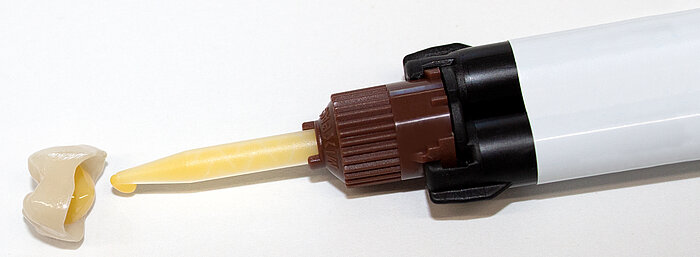Adhesive fastening of zirconium oxide
Thanks to the possibility of adhesive fastening of zirconium oxide, minimally invasive aesthetic restorations have found their way into dental technology.
"Adhesive" describes the adjective for "adhesion" which is derived from the Latin "adhaerere" and means something like "bonding without fusing with the sticky surface". Something that has been adhesively attached can therefore be removed again undamaged.
According to this, the use of adhesive attachment in dentistry does not require any surgical intervention and the neighboring teeth of that to be replaced do not need any extensive elaboration either.
Reasons in favor of adhesive fastening of zirconium oxide
As mentioned in the previous paragraph, no surgical intervention is necessary for adhesive fastening of zirconium oxide, which minimizes the risk for patients. However, the adhesive fixation of zirconium oxide is generally preferred to cementing. On the one hand, because the restoration can be removed almost completely without leaving any residue and the neighboring teeth remain undamaged, on the other hand because the composite, which serves as an adhesive bond, is more translucent and therefore more aesthetic than gray cement.
When to avoid adhesive fastening of zirconium oxide
Despite the many advantages of adhesive fastening of zirconium oxide, this is not always equal useful. For example, a restoration through adhesively fixed bridges is out of the question if the neighboring teeth are not healthy, not free of caries or the enamel coat is worn down.
If the neighboring teeth are not healthy or if they have to be crowned, it makes sense to grind down the teeth and use a normal bridge with the help of cement.
Adhesive bridges
Adhesive bridges - often also referred to as Maryland bridges or adhesive bridges - are still seen as a temporary solution before the definitive restoration is used.
According to Prof. Dr. Matthias Kern, who specializes with minimally invasive procedures in dentistry and the associated adhesively fixed dentures, the long-term performance of adhesive bridges is in no way inferior to that of conventional bridges or single-tooth implants with crowns. On the contrary: meta-analyses on restorations in the incisor area show that the long-term results of adhesive bridges made of zirconium are better than those of implant crowns.
Only 1 in 20 zirconia bridges bonded with adhesive is lost over a 10-year period, representing a 95% success rate. For comparison: with implant crowns it is five out of 50.
Two-wing adhesive bridges made of zirconium oxide
As the term "two-winged" already suggests, this type of restoration is a bridge framework with two wings - i.e. adhesive surfaces on two sides. The zirconium oxide framework is adhesively attached to both adjacent teeth.
Single-wing adhesive bridges made of zirconium oxide
The difference to the two-wing adhesive bridge results from the designation. Instead of two wings, the single-wing Maryland bridge only has one adhesive surface that is attached to one of the two adjacent teeth.
Contrary to original assumptions, the single-wing version of the adhesively fixed zirconium oxide bridge is the more stable one. If the pontic is attached to both neighboring teeth with the help of two adhesive surfaces, the natural freedom of movement of the teeth is severely restricted. As a result, the chewing forces act unchecked on the bridge and one of the two adhesive surfaces may detach from the neighboring tooth. If this circumstance is not immediately noticed by the patient, the resulting gap harbors a high risk of tooth decay.
However, the single-wing adhesive bridge offers even more advantages. Since it is a pontic with only one adhesive surface, it is less expensive. In addition, only one tooth has to be roughened for bonding and since no undercuts between the teeth have to be removed, the preparation is also much easier.
Adhesive fixation of zirconia in bruxism
As with any treatment with ceramic veneers for patients suffering from bruxism, the risk of chipping is also increased here. In principle, however, adhesive bridges do not pose a problem - as long as they are single-wing adhesive bridges. A few years ago, when two-wing adhesive bridges were predominant, adhesive treatment was considered contraindicated for bruxism patients, since the adhesive surfaces are exposed to enormous stress from the crunching.
CONCLUSIONS
All-ceramic adhesive bridges have now been used for over 20 years. A wealth of experience can therefore be drawn upon. This shows that even in the event of an accident, this type of supply does not break. If at all, the adhesive bridges come loose and can be reattached by the treating person.
There is also no need to worry about bone loss under adhesive bridges if the new tooth is placed correctly and the patient keeps it clean with dental floss.
Accordingly, when using the adhesive technique, it is not sufficient to use the right materials, but also to proceed correctly. Those treating the patient should know the procedure and be able to use it correctly in order to achieve the desired result in terms of function and aesthetics.
